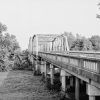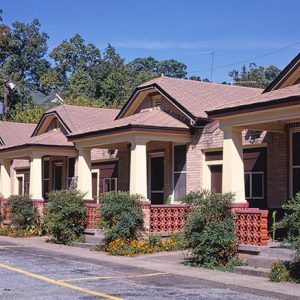calsfoundation@cals.org
Bellaire Court Historic District
The Bellaire Court Historic District is a tourist court in Hot Springs (Garland County). Constructed in 1936, the court consists of eight Craftsman bungalow-style cottages and a manager’s office. The district is also known as the Bellaire Apartments, as it was converted to apartments in the 1970s.
Located at 637 Park Avenue, the court is laid out in an L shape. The manager’s office faces Park Avenue, and five units are attached to the rear of the office, perpendicular to the street. The remaining three units are part of a separate building, facing Magnolia Avenue at the rear of the property. An asphalt driveway connects the property to Park Avenue.
Little is known about the construction of the court. Located along the original U.S. Highway 70, which linked Hot Springs and Little Rock (Pulaski County), the court was constructed in 1936. Service stations and restaurants were constructed along the street to support the increase in tourist traffic in the mid-twentieth century. A number of tourist courts were constructed along Park Avenue during this period to take advantage of the large number of tourists visiting the city. The Bellaire Court was one of the first constructed in the area.
The buildings are constructed from wood and covered in brick veneer, with Craftsman detailing on both the interior and exterior. Each unit was constructed with a single-car garage attached. A narrow alley separates the two single-story buildings. The manager’s unit includes a front porch facing Park Avenue. Each unit also includes a small porch with brick and stucco columns.
The earliest owner of the property that has been identified is Frank I. Clark in 1938. The property was known as the Bellaire Lodge Apartments during this period but, by 1939, it had been renamed the Bellaire Tourist Camp before becoming the Bellaire Tourist Court in 1943. In 1951, John H. Howard became the owner of the court. Over the next several decades, Hot Springs grew to the south, and new hotels and other amenities were constructed near Lake Hamilton. Tourists began visiting the courts along Park Avenue less, and in the 1970s, the Bellaire Court was converted to apartments. The garages attached to each unit were enclosed and converted into living space.
The court continues to be utilized as apartments in the twenty-first century. As an example of Craftsman-style bungalows and one of the first tourist courts constructed in the city, the Bellaire Court Historic District was added to the National Register of Historic Places on February 11, 2004.
For additional information:
Wiedower, Bill. “Bellaire Court Historic District.” National Register of Historic Places registration form. On file at Arkansas Historic Preservation Program, Little Rock, Arkansas. Online at http://www.arkansaspreservation.com/National-Register-Listings/PDF/GA0609.nr.pdf (accessed September 27, 2017).
David Sesser
Henderson State University








Comments
No comments on this entry yet.